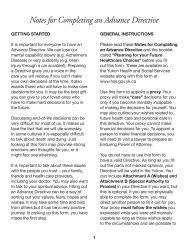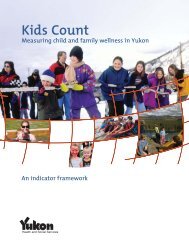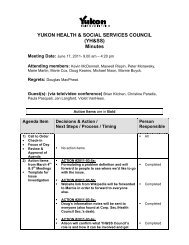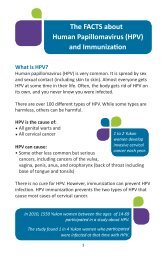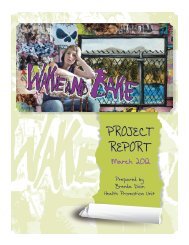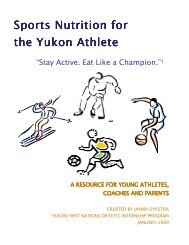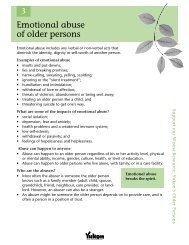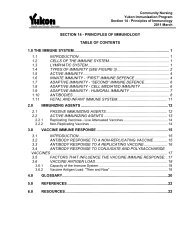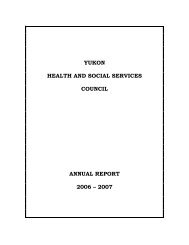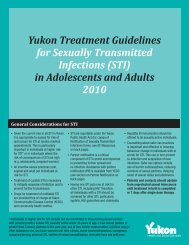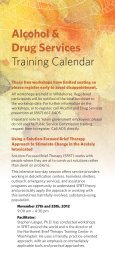Yukon Addictions Survey - Health and Social Services - Government ...
Yukon Addictions Survey - Health and Social Services - Government ...
Yukon Addictions Survey - Health and Social Services - Government ...
Create successful ePaper yourself
Turn your PDF publications into a flip-book with our unique Google optimized e-Paper software.
YUKON ADDICTIONS SURVEY (YAS)<br />
PRELIMINARY RESULTS 2005<br />
A survey of <strong>Yukon</strong>ers’ use of alcohol <strong>and</strong> other drugs
2005 <strong>Yukon</strong> <strong>Addictions</strong> <strong>Survey</strong><br />
The <strong>Yukon</strong> <strong>Addictions</strong> <strong>Survey</strong> is a joint project of the <strong>Yukon</strong> <strong>Government</strong>’s Department of <strong>Health</strong> <strong>and</strong> <strong>Social</strong> <strong>Services</strong><br />
<strong>and</strong> the <strong>Yukon</strong> Bureau of Statistics.<br />
This report presents selected, preliminary figures from the 2005 <strong>Yukon</strong> <strong>Addictions</strong> <strong>Survey</strong> (YAS). Future publications<br />
will provide a detailed account of YAS results.<br />
For further information on the 2005 <strong>Yukon</strong> <strong>Addictions</strong> <strong>Survey</strong> contact the Department of <strong>Health</strong> <strong>and</strong> <strong>Social</strong> Servicves<br />
at:<br />
<strong>Government</strong> of <strong>Yukon</strong><br />
Department of <strong>Health</strong> <strong>and</strong> <strong>Social</strong> <strong>Services</strong><br />
Communications (H-1)<br />
307 Black St.<br />
Whitehorse, <strong>Yukon</strong><br />
Y1A 2C6<br />
Phone: (867) 667-3673<br />
Fax: (867) 667-3096<br />
Email: patricia.living@gov.yk.ca<br />
Website: http://www.hss.gov.yk.ca/<br />
For further information about the activities or publications of the <strong>Yukon</strong> Bureau of Statistics contact:<br />
<strong>Government</strong> of <strong>Yukon</strong><br />
Executive Council Office<br />
Bureau of Statistics (A-8C)<br />
Box 2703<br />
Whitehorse, <strong>Yukon</strong><br />
Y1A 2C6<br />
Phone: (867) 667-5640<br />
Fax: (867) 393-6203<br />
Email: ybsinfo @gov.yk.ca<br />
Website: www.gov.yk.ca/depts/eco/stats/<br />
Please note: permission is granted to use the contents of this publication provided acknowledgement is given to:<br />
<strong>Government</strong> of <strong>Yukon</strong><br />
Department of <strong>Health</strong> <strong>and</strong> <strong>Social</strong> <strong>Services</strong><br />
2
2005 <strong>Yukon</strong> <strong>Addictions</strong> <strong>Survey</strong><br />
The <strong>Yukon</strong> <strong>Addictions</strong> <strong>Survey</strong> 2005 - Highlights Report<br />
This survey is <strong>Yukon</strong>’s portion of a national survey dedicated to assessing the prevalence of non-medical drug use.<br />
Since the 1990 <strong>Yukon</strong> Alcohol <strong>and</strong> Other Drugs <strong>Survey</strong>, there has been no other sample survey dedicated to<br />
monitoring the extent to which the population uses alcohol, tobacco <strong>and</strong> illicit drugs. Some questions about drug<br />
use—particularly about alcohol <strong>and</strong> tobacco—have been included in other national studies, but this is the first time in<br />
nearly 15 years that a population survey has focused on the non-medical, psychoactive use of alcohol <strong>and</strong> other<br />
drugs.<br />
The <strong>Yukon</strong> Addiction <strong>Survey</strong> (YAS) is comparable to the Canadian Addiction <strong>Survey</strong> (CAS). For the most part, the<br />
questions in the <strong>Yukon</strong> survey are identical to those in the CAS. As a result of field testing in <strong>Yukon</strong>, some items in<br />
the CAS have been eliminated <strong>and</strong> some items have been added to the YAS in order to best reflect <strong>Yukon</strong>’s<br />
experience.<br />
<strong>Yukon</strong>’s survey is really two surveys:<br />
1. A household survey conducted by telephone of a systematically <strong>and</strong> r<strong>and</strong>omly-generated population sample<br />
of 1240 respondents.<br />
2. A strategic sample of people thought to be at particularly high risk of experiencing harmful consequences of<br />
drug use. Respondents to this section of the study were recruited from downtown Whitehorse, including<br />
some street corners, a soup kitchen, the Salvation Army <strong>and</strong> a skateboard park. Respondents were<br />
interviewed face-to-face <strong>and</strong> received coupons for Subway as a gesture of appreciation (N=75).<br />
Findings<br />
The results of the <strong>Yukon</strong> <strong>Addictions</strong> <strong>Survey</strong> suggest that, for the most part, differences between <strong>Yukon</strong> <strong>and</strong> the rest of<br />
Canada are minor regarding the use of alcohol <strong>and</strong> other drug use. According to this first analysis of the data, a major<br />
difference is that <strong>Yukon</strong>’s rate of cannabis use is higher than that of Canada.<br />
Since the last alcohol <strong>and</strong> drugs survey in 1990, there has been an increase in light drinking <strong>and</strong> a decrease in heavy,<br />
frequent drinking, indicating that more people are adopting alcohol use styles where the likelihood of negative<br />
consequences is lower. The rate of tobacco use has decreased substantially, but cannabis use has increased since<br />
the 1990 survey.<br />
<strong>Yukon</strong>ers report that they have considerable access to illicit drugs, but there is little indication that, with the exception<br />
of cannabis, they are taking advantage of that access. For the general population, use levels of illicit drugs other than<br />
cannabis are very low. A perhaps surprising result of the current analysis is that <strong>Yukon</strong>ers who live in rural areas<br />
report greater access to illicit drugs than those who live in urban areas.<br />
The majority of <strong>Yukon</strong>ers who use any non-medical drug will use only alcohol. Less frequent, but also common, are<br />
multidrug use patterns involving alcohol, tobacco <strong>and</strong> cannabis. As was mentioned, rates of use of other drugs are<br />
not frequent in the general <strong>Yukon</strong> population.<br />
It is not uncommon to be affected by other people’s use of alcohol <strong>and</strong> drugs. Close to half of the <strong>Yukon</strong> population<br />
reported having been negatively affected in some way—mainly through verbal harassment or insults—by someone<br />
who has drunk too much or has taken drugs.<br />
Because it is difficult to capture data on problem use in a general population survey, the Bureau of Statistics<br />
conducted a strategic survey of high-risk respondents. These respondents had higher rates of use of all drugs with<br />
the exception of alcohol, where the proportion of users was similar to that of the general population. Regarding their<br />
drug use, outst<strong>and</strong>ing <strong>and</strong> perhaps most problematic were their high rates of heavy drinking <strong>and</strong> their high rates of<br />
cocaine use. Not surprisingly, access to most drugs for this group was high, <strong>and</strong> a very large majority of this group<br />
reported easy access to cocaine. Also of concern were the large proportions of those reporting victimization of all<br />
kinds from others who were drinking or who were using drugs.<br />
3
2005 <strong>Yukon</strong> <strong>Addictions</strong> <strong>Survey</strong><br />
Highlights of findings<br />
Alcohol Use<br />
• 79% of <strong>Yukon</strong>ers over the age of 15 reported the use of alcohol in the past 12 months, the same<br />
number for Canadians overall. This compares to 77% in 1990 who reported using alcohol in the<br />
past 12 months, an increase of 2%. 81% of <strong>Yukon</strong>ers in the high risk population reported using<br />
alcohol in the past 12 months.<br />
• The likelihood of using alcohol during the 12 months preceding the survey was higher for <strong>Yukon</strong><br />
males who live in urban areas. Males between the ages of 25-44 <strong>and</strong> 45-64 had the highest<br />
rates of drinking. In the high risk population it was more likely that they were a male in the 15-24<br />
yr age group.<br />
• The majority of <strong>Yukon</strong>ers in the general population reported light alcohol usage with an even<br />
number of respondents reporting light-frequent (31%) <strong>and</strong> light-infrequent (31%) use in the past<br />
12 months. In 1990 there was 27% who reported light-frequent <strong>and</strong> 28% light-infrequent alcohol<br />
use. Heavy frequent alcohol usage was 10% in 2005, down 4% from 14% who reported heavy<br />
frequent drinking in 1990.<br />
• 16% of <strong>Yukon</strong>ers who had consumed alcohol in the past year also reported smoking cigarettes<br />
while 9% reported using alcohol <strong>and</strong> cannabis in the past 12 months, <strong>and</strong> 7% reported using<br />
alcohol, tobacco <strong>and</strong> cannabis in combination. In the high risk population in <strong>Yukon</strong>, 11% reported<br />
using tobacco <strong>and</strong> alcohol together, 14% reported using tobacco, alcohol <strong>and</strong> cannabis, <strong>and</strong> 11%<br />
combined tobacco, alcohol, cannabis <strong>and</strong> cocaine.<br />
• On average, <strong>Yukon</strong>ers consumed 3.8 drinks per occasion, which compares to 4.2 drinks in 1990.<br />
The high risk population reported 10.4 drinks per occasion in the 2005 survey. The reported<br />
drinking occasions per month for <strong>Yukon</strong>’s general population was 6.7 per month compared to 6.5<br />
per month in 1990. The high risk population reported 11.9 drinking occasion in a month.<br />
Illicit Drug Use<br />
• 21% of <strong>Yukon</strong>ers over the age of 15 reported using cannabis in the past 12 months, compared to<br />
14% of Canadians overall. In 1990 there was 16% who reported using cannabis in the past 12<br />
months. 74% of <strong>Yukon</strong>ers in the high risk population reported using cannabis in the past 12<br />
months.<br />
• Over the past 12 months usage of other illicit drugs for <strong>Yukon</strong>ers reported shows 3% used<br />
cocaine, 1% used hallucinogenic drugs <strong>and</strong> 1% used ecstasy. These numbers are in line for<br />
similar usage of drugs in the Canadian population overall. In the high risk population 40% used<br />
cocaine, 18% used hallucinogenic drugs, 16% used ecstasy <strong>and</strong> 7% used methamphetamines<br />
(amphetamines, speed).<br />
4
2005 <strong>Yukon</strong> <strong>Addictions</strong> <strong>Survey</strong><br />
Highlights of findings<br />
• The likelihood of using cannabis during the 12 months preceding the survey was higher for<br />
<strong>Yukon</strong>ers in the general population between the ages of 25-44, male <strong>and</strong> living in urban<br />
areas. In the high risk population it was also more likely that they were a male in the 15-24<br />
yr age group.<br />
• 96% of <strong>Yukon</strong>ers in the high risk population reported it is easy to get marijuana when they<br />
want to, <strong>and</strong> 82% report it is easy to get cocaine. In the general population 77% reported it<br />
is easy to get marijuana while 51% reported it is easy to get access to cocaine.<br />
• Most users of cannabis in the general population are between the ages of 15-24, are male<br />
<strong>and</strong> live in an urban area. The main users in the high risk population are between 15-24<br />
<strong>and</strong> male.<br />
Multiple Drug Use<br />
• For 43% of <strong>Yukon</strong>ers, alcohol is the only drug used. There are 16% who use alcohol <strong>and</strong><br />
tobacco together, while 26% of <strong>Yukon</strong>ers use two or more licit or illicit drugs together such<br />
as using tobacco, alcohol <strong>and</strong> cannabis. The high risk group also used drugs in<br />
combination together, in fact, 88% had used two or more illicit drugs during the year prior to<br />
the survey.<br />
Availability<br />
• Access to drugs as reported in the <strong>Yukon</strong> 2005 survey illustrates that many <strong>Yukon</strong>ers find it<br />
relatively easy to access drugs. 77% of the respondents in the survey said that cannabis is<br />
‘fairly easy or ‘very easy’ to get, while 51% said the same for cocaine. For the high risk<br />
sample access to drugs was more common <strong>and</strong> overall higher for most drugs, 96% said that<br />
cannabis is ‘fairly easy or ‘very easy’ to get <strong>and</strong> 82% said cocaine is easy to get.<br />
Harms<br />
• <strong>Yukon</strong>ers have experienced harm as a result of someone else using alcohol or drugs. 31%<br />
said they have been insulted or harassed as a result of another person’s drinking while 71%<br />
of the high risk group said they had been insulted or harassed. While 19% of the general<br />
population reported being pushed or shoved, 64% of the high risk group had this<br />
experience.<br />
5
2005 <strong>Yukon</strong> <strong>Addictions</strong> <strong>Survey</strong><br />
Figure 1: Percentage of Alcohol <strong>and</strong> Other Drug Use in the Past Year, age 15+ (CAS 2004, YAS 2005)<br />
Cigarettes* Alcohol Cannabis Cocaine Methamphetamine Ecstacy Hallucinogens<br />
Canada 23 79 14 2 1 1 1<br />
<strong>Yukon</strong> - general 28 79 21 3 S 1 Q 1 Q<br />
Newfoundl<strong>and</strong> 24 74 12 1 Q S 1 Q S<br />
P.E.I. 24 70 11 1 Q S 1 Q 1 Q<br />
Nova Scotia 24 76 14 1 Q S 1 Q 1 Q<br />
New Brunswick 25 74 11 S 1 Q S S<br />
Quebec 26 82 16 3 Q 2 Q 1 Q 1 Q<br />
Ontario 22 79 12 1 Q S 1 Q S<br />
Manitoba 23 77 13 2 Q S S 1 Q<br />
Saskatchewan 24 78 11 2 Q S 1 Q 1 Q<br />
Alberta 23 80 15 2 S 1 Q 1 Q<br />
B.C. 19 79 17 3 1 Q 1 Q 1 Q<br />
<strong>Yukon</strong> – high risk 75 81 74 40 7 16 18<br />
1990 YADS** 41 77 16 n/a n/a n/a n/a<br />
The proportions of current drinkers for <strong>Yukon</strong> <strong>and</strong> Canada are identical at 79%, <strong>and</strong> the rates of cocaine users are<br />
comparable (3 versus 2%). Cannabis use in <strong>Yukon</strong> is considerably higher than use in provinces (21% versus 14%),<br />
while the rates of the use of other drugs for both <strong>Yukon</strong> <strong>and</strong> Canada are so low that any comparisons of statistics for<br />
speed, ecstasy, <strong>and</strong> hallucinogens would not be valid. Compared with respondents to the <strong>Yukon</strong> <strong>and</strong> Canada<br />
population surveys, those in the high risk groups have far higher rates of cannabis (74%) <strong>and</strong> cocaine use (40%).<br />
Figure 2 displays rates of alcohol, tobacco <strong>and</strong> cannabis use by the <strong>Yukon</strong> population in 1990 <strong>and</strong> 2005. According to<br />
these surveys, the proportion of the population who drinks alcohol has remained fairly stable, with 77% of the<br />
population having reported current drinking in 1990, <strong>and</strong> 79%, in 2005. Tobacco use has declined from 41% to 28%,<br />
while cannabis use has risen from 16% to 21% during the 15 year period.<br />
In contrast with the respondents in the population<br />
samples in <strong>Yukon</strong> <strong>and</strong> Canada, the exposure of the<br />
high risk group to the three drugs in question is far<br />
greater than for the general population samples.<br />
While their prevalence of alcohol use is similar to that<br />
of the population samples, a large majority has had<br />
cannabis, <strong>and</strong> 40% has used cocaine during the year<br />
prior to the survey. It should be noted that this high<br />
risk group is remarkable compared with the<br />
population groups. Their rates of illicit drug use are<br />
as high as they are because this sample was selected<br />
to enable a thorough examination of problem drinking<br />
<strong>and</strong> illicit drug use; such an examination is not<br />
possible in population samples, because (as is<br />
evident from the low rates of use of most illicit drugs)<br />
low counts do not permit valid analysis.<br />
90<br />
80<br />
70<br />
60<br />
50<br />
40<br />
30<br />
20<br />
10<br />
0<br />
Figure 2: Rates of Alcohol, Tobacco <strong>and</strong> Cannabis Use,<br />
<strong>Yukon</strong> 1990 (YADS) <strong>and</strong> <strong>Yukon</strong> 2005 (YAS), Age 15+<br />
77<br />
41<br />
16<br />
<strong>Yukon</strong> 1990 (YADS)<br />
79<br />
32<br />
21<br />
<strong>Yukon</strong> 2004 (YAS)<br />
Cigarettes<br />
Alcohol<br />
Cannabis<br />
In addition to the use of alcohol, cannabis <strong>and</strong> cocaine, the high risk sample has been exposed to other drugs in<br />
substantial proportions during the past year.<br />
Q Qualified release due to high sampling variability<br />
S Estimate suppressed due to unacceptably high sampling variability<br />
Estimates for heroin, inhalants, <strong>and</strong> steroids were not presented due to unacceptably high sampling variability<br />
* Canadian Community <strong>Health</strong> <strong>Survey</strong> (CCHS) 2003<br />
* *YADS (<strong>Yukon</strong> Alcohol <strong>and</strong> Drug <strong>Survey</strong>), 1990, <strong>Yukon</strong> Bureau of Statistics<br />
6
2005 <strong>Yukon</strong> <strong>Addictions</strong> <strong>Survey</strong><br />
Patterns of Alcohol Use<br />
The majority of Canadians <strong>and</strong> <strong>Yukon</strong>ers drink alcohol. Therefore, it is important to assess the way in which<br />
alcohol is used <strong>and</strong> the consequences of alcohol use. Most people who use alcohol do so without permanent,<br />
harmful consequences. Likewise, most occasions during which alcohol is used are benign occasions. However,<br />
heavier drinking, or consuming high quantities of alcohol on a given occasion, contributes considerably to<br />
physical, mental <strong>and</strong> social damage. Given the negative consequences associated with heavier drinking,<br />
assessment of drinking patterns, or the combination of quantity <strong>and</strong> frequency of alcohol use, can aid in informing<br />
the direction of social policy.<br />
Figure 3: Drinking status, <strong>Yukon</strong> 2005 (YAS), <strong>Yukon</strong>1990 (YADS) <strong>and</strong> Canada 2004 (CAS), Age15+,<br />
Past 12 months<br />
Status<br />
1990<br />
YADS<br />
2005<br />
YAS<br />
General<br />
2005<br />
YAS<br />
High<br />
Risk<br />
2004<br />
CAS<br />
Definition<br />
Abstainer 4% 10% 7% 7% Never had alcohol beyond sips or tastes.<br />
Former 19% 10% 17% 14%<br />
Drank sometime during their lives but not during the 12<br />
months preceding the survey<br />
Current 77% 79% 77% 79% Drank during the 12 months preceding the survey<br />
Drinking status of Current Drinkers, <strong>Yukon</strong> 2005 (YAS), <strong>Yukon</strong>1990 (YADS) <strong>and</strong> Canada 2004 (CAS),,<br />
Age15+, Past 12 months<br />
Status<br />
Light<br />
infrequent<br />
Light<br />
frequent<br />
Heavy<br />
infrequent<br />
Heavy<br />
frequent<br />
1990<br />
YADS<br />
2005<br />
YAS<br />
General<br />
2005<br />
YAS<br />
High Risk<br />
2004<br />
CAS<br />
28% 31% 7% 39%<br />
27% 31% 5% 28%<br />
8% 8% 17% 6%<br />
14% 10% 48% 7%<br />
Definition<br />
Current Drinkers who drink less often than once a week<br />
usually fewer than five drinks when alcohol is used<br />
Current Drinkers who drink once a week or more usually<br />
fewer than five drinks when alcohol is used<br />
Current Drinkers who drink less often than once a week<br />
usually five drinks or more drinks when alcohol is use<br />
Current Drinkers who drink once a week or more usually<br />
five drinks or more drinks when alcohol is used<br />
Figure 3 displays the proportions of respondents<br />
in the different drinking status categories for<br />
<strong>Yukon</strong>, general population in 1990 <strong>and</strong> the two<br />
recent population surveys in <strong>Yukon</strong> (general <strong>and</strong><br />
high risk) <strong>and</strong> Canada.<br />
The majority of people in <strong>Yukon</strong> <strong>and</strong> in Canada<br />
are in the light drinking categories: they drink<br />
smaller amounts of alcohol either frequently or<br />
infrequently. <strong>Yukon</strong> has somewhat less light,<br />
infrequent drinkers than does the rest of Canada<br />
(31% versus 39%).<br />
Figure 4: Drinking Status in Year Preceding <strong>Survey</strong><br />
31% 31%<br />
28% 27%<br />
7%<br />
39%<br />
5%<br />
28%<br />
1990 YADS<br />
2005 YAS General<br />
2005 YAS High Risk<br />
2004 CAS<br />
8% 8%<br />
48%<br />
17%<br />
14%<br />
10%<br />
6% 7%<br />
Light infrequent Light frequent Heavy infrequent Heavy frequent<br />
7
2005 <strong>Yukon</strong> <strong>Addictions</strong> <strong>Survey</strong><br />
Since 1990, there may have been an increase in the proportion of lighter drinkers, indicating that more<br />
people are using alcohol in a benign manner.<br />
One fifth of <strong>Yukon</strong>ers (20%) <strong>and</strong><br />
those living in the provinces<br />
(20%) do not drink. Canada has<br />
slightly less life abstainers than<br />
does <strong>Yukon</strong> (7% versus 10%) <strong>and</strong><br />
more people who once drank, but<br />
no longer have alcohol (14%<br />
versus 10%). The proportion of<br />
life abstainers has increased<br />
since 1990, <strong>and</strong> that of former<br />
drinkers has decreased. The rate<br />
of heavy drinking is somewhat<br />
higher in <strong>Yukon</strong> than in Canada<br />
(18% versus 13%). The data<br />
from the two <strong>Yukon</strong> surveys<br />
suggest that heavy frequent<br />
drinking—the highest risk kind of<br />
drinking—has decreased since<br />
1990 by 4%.<br />
Figure 5 : Mean Number of Drinks per Occassion in <strong>Yukon</strong><br />
1990, 1993* <strong>and</strong> 2005, Current Drinkers, Age 15+<br />
4.15<br />
3.46<br />
1990 1993 2005<br />
3.78<br />
An important component of the drinking status measure just discussed is the usual number of drinks on<br />
an occasion, as this differentiates heavy from lighter drinkers, <strong>and</strong> heavier drinkers are at greater risk of<br />
harm. Figure 5 illustrates changes in this measure for three time points: 1990, 1993, <strong>and</strong> 2005.<br />
<strong>Yukon</strong>ers reported a higher average number of drinks in 1990 than they did in 1993 <strong>and</strong> 2005. The<br />
current survey indicates a rise in this average from 1993.<br />
The high risk sample has a very different<br />
distribution of drinking pattern<br />
categories. The chart below suggests<br />
that the heavy drinking pattern is a usual<br />
one for this group.<br />
Clear from this chart is that, whatever<br />
other drugs are being used by this<br />
group, alcohol is of concern, as, when<br />
most of these people drink, they drink<br />
heavily. This group also contains a<br />
higher proportion of former drinkers than<br />
does the <strong>Yukon</strong> population sample.<br />
Current drinkers in this sample reported<br />
that their usual number of drinks on their<br />
drinking occasions was the average of<br />
10.4; this is close to three times the<br />
average amount reported by numbers of<br />
the general population sample.<br />
Figure 6: Drinking Pattern for <strong>Yukon</strong> High Risk Group, 2005<br />
Heavy<br />
Drinker<br />
64%<br />
Abstain<br />
7%<br />
Light<br />
Drinker<br />
12%<br />
Former<br />
Drinker<br />
17%<br />
*1993 <strong>Yukon</strong> <strong>Health</strong> Promotion <strong>Survey</strong> (YHPS)<br />
8
2005 <strong>Yukon</strong> <strong>Addictions</strong> <strong>Survey</strong><br />
Illicit Drug Use<br />
Respondents were questioned about their<br />
experiences with illicit drugs: whether or not<br />
access to them was easy or difficult,<br />
whether or not they were exposed to these<br />
drugs, <strong>and</strong> whether or not they were harmed<br />
by the use of these drugs.<br />
<strong>Yukon</strong> reported numbers similar to the rest<br />
of Canada for illicit drugs such as cocaine<br />
(3%), speed (1%), ecstasy (1%) <strong>and</strong><br />
hallucinogens (1%).<br />
Cannabis use has risen from 16% to 21%<br />
from the 1990 <strong>Yukon</strong> survey to 2005 <strong>and</strong> is<br />
the highest in Canada for the past year.<br />
British Columbia has the next highest<br />
reported percentage in Canadian provinces<br />
(17%), for the past year. Rates in the high<br />
risk population are much higher than the<br />
general population in the <strong>Yukon</strong> for reported<br />
use of cannabis in the past 12 months (74%).<br />
Figure 7: Illicit Drug Use in the Past 12 months, <strong>Yukon</strong> 2005<br />
(YAS) <strong>and</strong> Canada 2004 (CAS), Age 15+<br />
21%<br />
14%<br />
3%<br />
2%<br />
0%<br />
Cannabis Cocaine Speed Ecstacy Hallucinogens<br />
1%<br />
<strong>Yukon</strong> 2005 (YAS)<br />
Canada 2004 (CAS)<br />
1%<br />
1%<br />
1%<br />
Figure 8: Percentage of Cannabis Use, <strong>Yukon</strong> 2005, Canada,<br />
2004 <strong>and</strong> <strong>Yukon</strong> 1990, in the Past Year, Age 15+<br />
1%<br />
The majority of cannabis users in the general<br />
population (42%) are between the ages of 25-<br />
44 while 56% of users in the high risk<br />
population are between the ages of 15-24.<br />
The split between males (53%) <strong>and</strong> female<br />
users (47%) in the general population is<br />
closer than the split between males <strong>and</strong><br />
females in the high risk population.<br />
21%<br />
74%<br />
14% 16%<br />
<strong>Yukon</strong> General<br />
2005<br />
<strong>Yukon</strong> High Risk<br />
2005<br />
Canada 2004 <strong>Yukon</strong> 1990<br />
Figure 9: Cannabis Use, Past Year, General <strong>and</strong> High Risk<br />
Populations, broken down by age, <strong>Yukon</strong> 2005 (YAS)<br />
Figure 10: Cannabis Use, Past Year, General <strong>and</strong> High Risk<br />
Populations, broken down by gender, <strong>Yukon</strong> 2005 (YAS)<br />
29%<br />
56%<br />
42%<br />
35%<br />
29%<br />
General<br />
High Risk<br />
63%<br />
68%<br />
37%<br />
General<br />
High Risk<br />
32%<br />
9%<br />
0%<br />
0%<br />
15-24 25-44 45-64 65+<br />
Male<br />
Female<br />
9
2005 <strong>Yukon</strong> <strong>Addictions</strong> <strong>Survey</strong><br />
Availability of Illicit Drugs<br />
The use of drugs is largely dependent upon accessibility. Components of accessibility include the price<br />
<strong>and</strong> scope of distribution. First, however, knowledge of where <strong>and</strong> how to acquire a drug is necessary to<br />
its use, <strong>and</strong> this knowledge differs according to the drug itself, <strong>and</strong> is differentially distributed in<br />
populations. For each drug, respondents were asked whether it was “probably impossible,” “very<br />
difficult,” “fairly difficult,” “fairly easy” or “very easy” for them to get that drug. Figure 11 displays the<br />
proportions of the <strong>Yukon</strong> population who reported it was easy to acquire the drug.<br />
It is not surprising that the drug with<br />
the greatest proportion of ease of<br />
acquisition is solvents/glue, as this<br />
is not a controlled substance. Of<br />
the illicit drugs, over three quarters<br />
(77%) of the population report that<br />
marijuana is easy to get, <strong>and</strong> half of<br />
<strong>Yukon</strong>ers (51%) claim that that<br />
cocaine or crack can be gotten with<br />
ease. Substantial proportions of the<br />
population (30% to 43%) report that<br />
it is easy to get ecstasy,<br />
hallucinogens, methamphetamine,<br />
<strong>and</strong> heroin, in that order. In<br />
general, <strong>and</strong> for the population as a<br />
whole, substantial proportions are<br />
able to obtain all of the drugs listed<br />
here.<br />
Figure 11: Percentage of Respondents Reporting it is "fairly<br />
easy" or "very easy" to Get Drugs in Rural <strong>and</strong> Urban Areas,<br />
<strong>Yukon</strong> 2005, Age 15+<br />
Solvents<br />
Heroin<br />
Methamphetamine<br />
Cocaine<br />
Ecstasy<br />
Hallucinogen<br />
Cannabis<br />
29%<br />
33%<br />
36%<br />
41%<br />
48%<br />
59%<br />
40%<br />
48%<br />
40%<br />
45%<br />
75%<br />
82%<br />
89%<br />
93%<br />
Urban<br />
Rural<br />
Figure 11 depicts rates of claiming it is fairly easy or easy to get drugs in rural <strong>and</strong> in urban areas.<br />
Consistently—<strong>and</strong> in the case of<br />
cocaine/crack with an 11%<br />
difference—rates of ease of<br />
acquisition were reported to be<br />
higher in the rural than in the<br />
urban areas.<br />
Members of the high risk group<br />
are members of social groups<br />
where illicit drug use is more<br />
common <strong>and</strong> where availability<br />
would be expected to be higher<br />
than that of the general<br />
population. Almost all members<br />
of this group (96%) report that it is<br />
easy to get marijuana, <strong>and</strong> 82%<br />
find it easy to get cocaine or<br />
crack, as well.<br />
Figure 12: Percentage of Respondents Reporting it is "fairly easy"<br />
or "very easy" to Get Drugs, <strong>Yukon</strong> 2005, Age 15+, High Risk<br />
Sample<br />
Solvents<br />
Heroin<br />
Methamphetamine<br />
Cocaine<br />
Ecstasy<br />
Hallucinogen<br />
Cannabis<br />
30%<br />
51%<br />
58%<br />
56%<br />
82%<br />
90%<br />
96%<br />
10
2005 <strong>Yukon</strong> <strong>Addictions</strong> <strong>Survey</strong><br />
Multiple Drug Use<br />
When drugs are used, it is common to use more than one drug. For example, it is fairly common to use<br />
both tobacco <strong>and</strong> alcohol; tobacco users rarely abstain from alcohol use. When illicit drugs are used, it<br />
is common to use at least one other licit or illicit drug.<br />
Figure 13: <strong>Yukon</strong>ers <strong>and</strong> Drug Use Patterns in Percentages,<br />
<strong>Yukon</strong> 2005 (YAS), Age 15+<br />
Other<br />
5%<br />
No drugs<br />
15%<br />
Alcohol only<br />
43%<br />
Alcohol <strong>and</strong> cannabis<br />
9%<br />
Tobacco only<br />
5%<br />
Tobacco <strong>and</strong> alcohol<br />
16%<br />
Tobacco, alcohol, cannabis<br />
7%<br />
For nearly half of <strong>Yukon</strong>ers (43%), alcohol is the only non-medical drug that is used. Fifteen percent of<br />
the population aged 15 <strong>and</strong> over uses no drugs <strong>and</strong> 16% uses alcohol <strong>and</strong> tobacco. One in five<br />
<strong>Yukon</strong>ers (21%) uses some illicit drug in addition to another licit or illicit drug.<br />
Drug use patterns for the high risk group do not cluster in the same way as for the general population.<br />
Twenty-three percent of this sample does not use illicit drugs, <strong>and</strong> 88% has used two or more licit <strong>and</strong><br />
illicit substances during the year prior to the survey.<br />
The most common combinations of drug use are:<br />
Tobacco <strong>and</strong> alcohol: 11%<br />
Tobacco, alcohol <strong>and</strong> cannabis: 14%<br />
Tobacco, alcohol, cannabis <strong>and</strong> cocaine: 11%.<br />
There were also just under 5% of the high risk population who had not used alcohol, cigarettes or any<br />
illicit drugs in the year prior to the survey.<br />
11
2005 <strong>Yukon</strong> <strong>Addictions</strong> <strong>Survey</strong><br />
Harm as a Result of Alcohol <strong>and</strong> other Drug Use<br />
The <strong>Yukon</strong> <strong>Addictions</strong> <strong>Survey</strong> has a section on victimization <strong>and</strong> asked whether or not the respondent had been<br />
harmed by another person’s drinking or drug use during the past 12 months. Specific types of harm included in the<br />
survey are:<br />
· Being insulted or harassed<br />
· Having family problems<br />
· Being pushed or shoved<br />
· Having arguments due to the drinking or drug use of another person.<br />
In addition, there were two items querying whether verbal abuse had occurred by:<br />
· A drug user or<br />
· A drinker<br />
Figure 14: Percentages of Population <strong>and</strong> High Risk<br />
Respondents Reporting Specific Types of Harm<br />
during the Past 12 Months. <strong>Yukon</strong> 2005, Age 15+<br />
Verbal Abuse by<br />
Drinker<br />
Verbal Abuse by<br />
Drug User<br />
Arguments<br />
Pushed or shoved<br />
Family problems<br />
Insulted/Harrassed<br />
15<br />
15<br />
19<br />
26<br />
28<br />
31<br />
44<br />
56<br />
64<br />
68<br />
69<br />
High Risk<br />
General<br />
71<br />
A considerable proportion of <strong>Yukon</strong>ers are<br />
currently harmed by the behaviour of others<br />
which may have been caused or made more<br />
severe through the use of alcohol or other<br />
drugs. The data also suggest that some<br />
victimization by people who drink too much<br />
or use drugs is not uncommon, with close to<br />
a third of the population reporting insults,<br />
harassment or verbal abuse.<br />
The contrast between the general population<br />
<strong>and</strong> the high risk samples in rates of all harm<br />
suggests that respondents in the high risk<br />
sample live their lives in a milieu where drug<strong>and</strong><br />
alcohol-affected disturbing behaviour is<br />
the rule, rather than the exception. A<br />
comparison between the two samples in<br />
terms of the number of different types of<br />
harm experienced in the past 12 months<br />
illustrates this point further.<br />
Figure 15: Percentages of <strong>Yukon</strong> <strong>and</strong> High Risk Samples Reporting No Harm, 1-2 Types of Harm,<br />
<strong>and</strong> 3+ Types of Harm During the Past Year. <strong>Yukon</strong> 2005, Age 15+<br />
1-2 Harms,<br />
21%<br />
No Harm,<br />
16%<br />
No Harm,<br />
54%<br />
3+ Harms,<br />
77%<br />
1-2 Harms,<br />
7%<br />
3+ Harms,<br />
25%<br />
General<br />
High Risk<br />
While a majority of the general population reported experiencing no harm from others who drank or took drugs<br />
during the past year, a large majority of the high risk sample reported having been victimized through three or more<br />
types of harm by someone who drank or used drugs.<br />
12


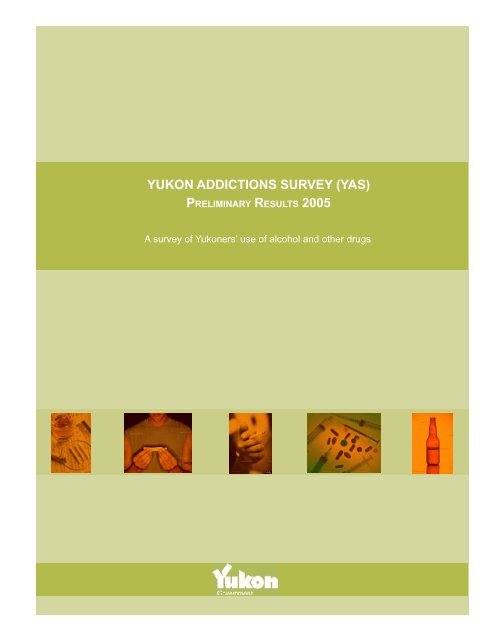
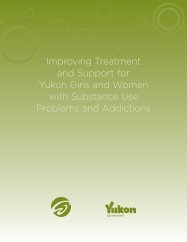
![Women and Alcohol: A women's health resource [2326.26 KB ]](https://img.yumpu.com/22340649/1/190x245/women-and-alcohol-a-womens-health-resource-232626-kb-.jpg?quality=85)
